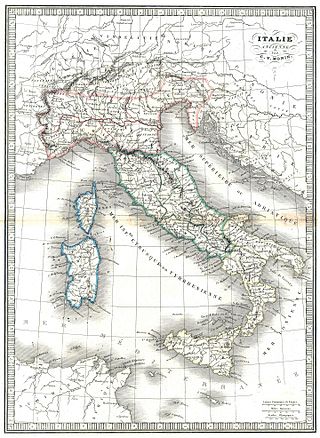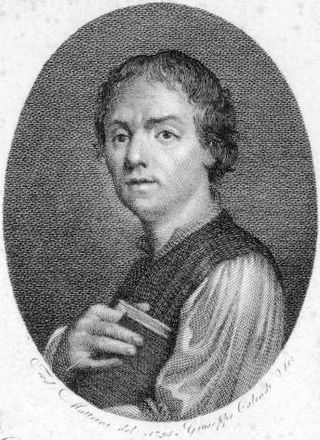Related Research Articles

Claudio Giovanni Antonio Monteverdi was an Italian composer, choirmaster and string player. A composer of both secular and sacred music, and a pioneer in the development of opera, he is considered a crucial transitional figure between the Renaissance and Baroque periods of music history.

Pietro Bembo, O.S.I.H. was an Italian scholar, poet, and literary theorist who also was a member of the Knights Hospitaller, and a cardinal of the Roman Catholic Church. As an intellectual of the Italian Renaissance, Pietro Bembo greatly influenced the development of the Tuscan dialect as a literary language for poetry and prose, which, by later codification into a standard language, became the modern Italian language. In the 16th century, Bembo's poetry, essays and books proved basic to reviving interest in the literary works of Petrarch. In the field of music, Bembo's literary writing techniques helped composers develop the techniques of musical composition that made the madrigal the most important secular music of 16th-century Italy.

Adrian Willaert was a Flemish composer of High Renaissance music. Mainly active in Italy, he was the founder of the Venetian School. He was one of the most representative members of the generation of northern composers who moved to Italy and transplanted the polyphonic Franco-Flemish style there.
Giaches de Wert was a Franco-Flemish composer of the late Renaissance, active in Italy. Intimately connected with the progressive musical center of Ferrara, he was one of the leaders in developing the style of the late Renaissance madrigal. He was one of the most influential of late sixteenth-century madrigal composers, particularly on Claudio Monteverdi, and his later music was formative on the development of music of the early Baroque era.

Cipriano de Rore was a Franco-Flemish composer of the Renaissance, active in Italy. Not only was he a central representative of the generation of Franco-Flemish composers after Josquin des Prez who went to live and work in Italy, but he was one of the most prominent composers of madrigals in the middle of the 16th century. His experimental, chromatic, and highly expressive style had a decisive influence on the subsequent development of that secular music form.

A madrigal is a form of secular vocal music most typical of the Renaissance and early Baroque (1600–1750) periods, although revisited by some later European composers. The polyphonic madrigal is unaccompanied, and the number of voices varies from two to eight, but usually features three to six voices, whilst the metre of the madrigal varies between two or three tercets, followed by one or two couplets. Unlike the verse-repeating strophic forms sung to the same music, most madrigals are through-composed, featuring different music for each stanza of lyrics, whereby the composer expresses the emotions contained in each line and in single words of the poem being sung.

Gioseffo Zarlino was an Italian music theorist and composer of the Renaissance. He made a large contribution to the theory of counterpoint as well as to musical tuning.

The Venetian polychoral style was a type of music of the late Renaissance and early Baroque eras which involved spatially separate choirs singing in alternation. It represented a major stylistic shift from the prevailing polyphonic writing of the middle Renaissance, and was one of the major stylistic developments which led directly to the formation of what is now known as the Baroque style. A commonly encountered term for the separated choirs is chori spezzati—literally, "broken choruses" as they were called, added the element of spatial contrast to Venetian music. These included the echo device, so important in the entire baroque tradition; the alternation of two contrasting bodies of sound, such as chorus against chorus, single line versus a full choir, solo voice opposing full choir, instruments pitted against voices and contrasting instrumental groups; the alternation of high and low voices; soft level of sound alternated with a loud one; the fragmentary versus the continuous; and blocked chords contrasting with flowing counterpoint.

In music history, the Venetian School was the body and work of composers working in Venice from about 1550 to around 1610, many working in the Venetian polychoral style. The Venetian polychoral compositions of the late sixteenth century were among the most famous musical works in Europe, and their influence on musical practice in other countries was enormous. The innovations introduced by the Venetian school, along with the contemporary development of monody and opera in Florence, together define the end of the musical Renaissance and the beginning of the musical Baroque.
Giovanni Croce was an Italian composer of the late Renaissance, of the Venetian School. He was particularly prominent as a madrigalist, one of the few among the Venetians other than Monteverdi and Andrea Gabrieli.
Gioseffo Guami was an Italian composer, organist, violinist and singer of the late Renaissance Venetian School. He was a prolific composer of madrigals and instrumental music, and was renowned as one of the finest organists in Italy in the late 16th century; he was also the principal teacher of Adriano Banchieri.

The modern state of Italy did not come into being until 1861, though the roots of music on the Italian Peninsula can be traced back to the music of ancient Rome. However, the underpinnings of much modern Italian music come from the Middle Ages.
The decade of the 1530s in music involved some significant events, publications, compositions, births, and deaths.
The decade of the 1540s in music involved some significant events.

Girolamo Parabosco was an Italian writer, composer, organist, and poet of the Renaissance.
Jacquet de Berchem was a Franco-Flemish composer of the Renaissance, active in Italy. He was famous in mid-16th-century Italy for his madrigals, approximately 200 of which were printed in Venice, some in multiple printings due to their considerable popularity. As evidence of his widespread fame, he is listed by Rabelais in Gargantua and Pantagruel as one of the most famous musicians of the time, and the printed music for one of his madrigals appears in a painting by Caravaggio.
Perissone Cambio was a Franco-Flemish composer and singer of the Renaissance, active in Venice. He was one of the most prominent students and colleagues of Adrian Willaert during the formative years of the Venetian School, and published several books of madrigals in the 1540s.
Antonino Barges was a Franco-Flemish composer of the Renaissance, active in Venice and Treviso. While known as a composer of light popular secular forms such as the villotta, he also wrote motets and a Requiem. He was a friend and probably a student of Adrian Willaert, the founder of the Venetian School, and was listed as a witness to Willaert's last will and testament.
Francesco Portinaro was an Italian composer and humanist of the Renaissance, active both in northern Italy and in Rome. He was closely associated with the Ferrarese Este family, worked for several humanistic Renaissance academies, and was well known as a composer of madrigals and dialogues.
Paolo Isnardi was a late-Renaissance choirmaster and composer.
References
- ↑ Bernstein, Jane A. (1998). Music Printing in Renaissance Venice: The Scotto Press (1539-1572). Oxford University Press. p. 72. ISBN 9780195102314 . Retrieved August 29, 2013.
- 1 2 Pratt, Waldo Selden. The History of Music. New York: G. Schirmer, Inc., 1907. 121.
- 1 2 Fenlon, Iain (2009). Early Music History: Volume 27: Studies in Medieval and Early Modern Music. Cambridge University Press. pp. 207–208. ISBN 9780521760034 . Retrieved August 29, 2013.
- 1 2 McKinney, Timothy R. (2010). Adrian Willaert and the Theory of Interval Affect: The Musica Nova Madrigals and the Novel Theories of Zarlino and Vicentino. Ashgate Publishing, Ltd. p. 278. ISBN 9780754696728 . Retrieved August 29, 2013.